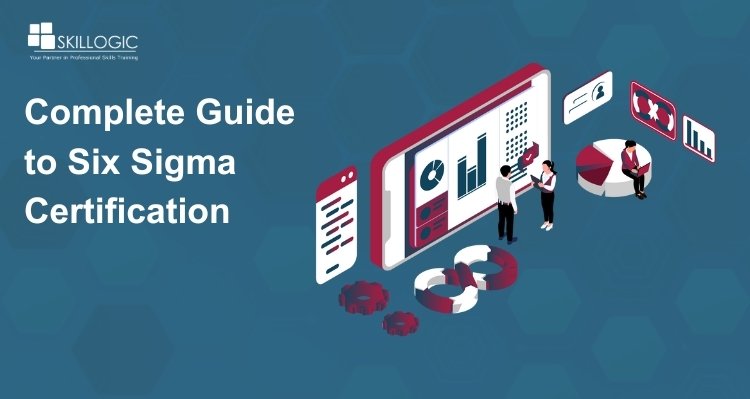Complete Guide to Six Sigma Certification

One of the most popular techniques for process improvement right now is Six Sigma. It provides a set of requirements that companies must adhere to in order to lessen operational waste and redundancy, and ultimately decrease errors, defects, and waste.
Six sigma employs a number of techniques to identify deviations and address problems. The data-driven management approach used by six sigma is used to optimize and improve company processes. The fundamental structure consists of a strong client focus and a competent use of facts and statistics to reach a result.
For business processes to be improved, Six Sigma is necessary. Every professional across all industries needs a Six Sigma Certification, and earning a White, Yellow, Green, or Black Belt in the methodology is particularly advantageous.
In this blog you will find all the information you require regarding Six Sigma Certifications.
What Is Six Sigma?
A quality management strategy called Six Sigma helps people or businesses reduce or get rid of flaws in their goods and services. It is a collection of methods that aid in raising the standard of your work.The Six Sigma methodology improves processes with unidentified problems rather than relying on informed assumptions. A professional can determine how much work is still needed to perfect a specific method using the statistical term "Sigma."
Read these articles:
What Is Six Sigma Certification?
The Six Sigma Certification guarantees that a professional who holds it has been exposed to the whole Six Sigma Body of Knowledge (BoK).
The Five Levels of Six Sigma Certification are as follows:
- White Belt
- Yellow Belt
- Green Belt
- Black Belt
- Master Black Belt
What is Six Sigma
Types Of Six Sigma Certification
Six Sigma Certification training comes in five different forms.
Six Sigma White Belt- The goal of Six Sigma White Belt certified training programmes is to provide you a basic understanding of the Lean Six Sigma framework. Process optimization, variability, and detrimental consequences on process performance are all included. It provides a summary of the exact roles that each team member plays.
Six Sigma Yellow Belt- A beginner-level course is Six Sigma Yellow Belt. You learn a few fundamental procedures from it. In addition to significant measurements, it also discusses some of the fundamental improvement processes.
Six Sigma Green Belt- The Six Sigma Green Belt certification training and certification course enables professionals to learn how to design charts, process maps, and manage a comprehensive plan to direct other staff members in describing the Six Sigma duties inside a business. Most team leaders or senior team members who work closely with the team leader have the distinction of "Green Belt."
Six Sigma Black Belt- Factorial experiments, multiple regression, and descriptions of many types of process optimization are all possible throughout the Six Sigma Black Belt Certification course. A Black Belt should have an understanding of team dynamics and be able to designate responsibilities for team members based on their level of expertise.
Six Sigma Master Black Belt- The most advanced Six Sigma certification curriculum is the two-week Master Black Belt training. It gives a cutting-edge and laser-focused perspective on statistical techniques and Six Sigma projects. If you work with teams or are in executive leadership, this certification course can be helpful. The Master Black Belt Six Sigma professional should be able to respond to queries about procedure and be able to solve any challenging technological problems.
Methodologies Of Six Sigma
There are two primary Six Sigma methodologies:
DMAIC- Define, Measure, Analyze, Improve, and Control are represented by each letter. This relates to a quality plan that is data-driven and aimed at improving the process. The majority of business processes that use this strategy are those that already exist. In the end, this approach always makes the process better by addressing issues and reducing possible issues in the future.
DMADV- Define, Measure, Analyze, Design, and Verify are all represented here by individual letters. This relates to facts that have influenced quality strategy in terms of designing products and procedures. This technique has been used to develop new designs for products and process designs in a way that makes the outcomes more foreseeable, realistic, mature, and devoid of flaws and performance-impairing errors. This approach always places an emphasis on the steps taken to satisfy the needs of the client, and the client will also evaluate the effectiveness of the design.
Read these following articles:
- What is the Six Sigma Certification Cost in Bangalore
- How much does the Lean Six Sigma Certification Cost in Chennai?
- How much does the Lean Six Sigma Certification Cost in Pune?
Benefits Of Six Sigma Certification
- Your employer and its clients will value you more if you have a Six Sigma certification.
- helps you increase customer satisfaction, product quality, and service standards
- Reduce the process cycle time, which allows for up to 30% reduction in overall costs.
- helps you in the project definition process to discover and enhance needs.
- How should products and processes be measured?
- provides assistance with data analysis and hypothesis testing.
- It enables potential steps for improving how variations perform.
- They are a good fit for achieving company objectives.
- Higher jobs inside the firm will become available to you.
- You have better possibilities of getting promoted with this certification training.
- By utilizing Six Sigma tools and approaches, you can simplify your current job.
- Overall business growth
Fina Note
The goal of the Six Sigma is to teach individuals how to evaluate results and processes in order to cut down on waste and errors. There are different certification levels, ranging from primary end user to master Six Sigma user, who serves as a senior quality control member.
Utilizing Six Sigma can decrease waste and defects, hence raising a company's value to customers and end users, which benefits both employees and employers. As a result, there may be increased customer happiness, increased sales, better pay, and improved goods. Opt the Six Sigma certification from SKILLOGIC, a global training institute.
What is Quality
Six Sigma Green Belt Introduction
Six Sigma Black Belt Training Introduction

 admin
admin 



